|
|
home |
|
You need to exercise for about 60 minutes every
day. Setting aside 60 minutes all at once each day is one way to get in enough
exercise. If you wait until the end of the day to squeeze it in, you probably
wonít exercise enough or at all. If youíre not active for 60 minutes straight,
itís okay to exercise for 10 or 20 minutes at a time throughout the day.
Different exercises
No matter what your shape Ė apple, pear, ruler,
or hourglass Ė there's an exercise for you!
- Pick exercises you like to do and choose a
few different options so you donít get bored.
- Aim to exercise most days of the week. If
youíre not very active right now, start slowly and work your way up to being
active every day.
There are three levels of physical activity.
- Light Ė not sweating; not
breathing hard (slow walking, dancing)
- Moderate Ė breaking a sweat;
can talk but canít sing (walking fast, dancing)
- Vigorous Ė sweating,
breathing hard, canít talk or sing (running, swimming laps)
No matter what level you are exercising at, the
activity can be one of two types.
|
Exercise Type
|
What is it?
|
Why do it?
|
|
Resistance exercise (2 or more days each week)
|
Weight-training using weight machines and
resistance bands, or doing push-ups |
- Increases strength
- Builds muscles
|
|
Weight-bearing exercise |
Walking, running, hiking, dancing, gymnastics,
soccer, and other activities that work bones and muscles against gravity.
|
|
What kind of exercise does your body
need?
Your exercise should increase your heart rate
and move the muscles in your body. Swimming, dancing, skating, playing soccer,
or riding a bike are all examples of exercise that does these things.
Looking at fitness and your body closer up, your
exercise should include something from each of these four basic fitness areas:
 Cardio-respiratory
endurance is the same thing as aerobic endurance. It is the ability to
exercise your heart and lungs nonstop over certain time periods. When you
exercise, your heart beats faster, sending more needed oxygen to your body.
If you are not fit, your heart and lungs have to work harder during
exercise. Long runs and swims are examples of activities that can help your
heart and lungs work better. Cardio-respiratory
endurance is the same thing as aerobic endurance. It is the ability to
exercise your heart and lungs nonstop over certain time periods. When you
exercise, your heart beats faster, sending more needed oxygen to your body.
If you are not fit, your heart and lungs have to work harder during
exercise. Long runs and swims are examples of activities that can help your
heart and lungs work better. |
 Muscular
strength is the ability to move a muscle against resistance. To become
stronger, you need to push or pull against resistance, such as your own
weight (like in push-ups), using free weights (note: talk to an instructor
before using weights), or even pushing the vacuum cleaner. Regular exercise
keeps all of your muscles strong and makes it easier to do daily physical
tasks. Muscular
strength is the ability to move a muscle against resistance. To become
stronger, you need to push or pull against resistance, such as your own
weight (like in push-ups), using free weights (note: talk to an instructor
before using weights), or even pushing the vacuum cleaner. Regular exercise
keeps all of your muscles strong and makes it easier to do daily physical
tasks. |
 Muscular endurance is
the ability of a muscle, or a group of muscles, to keep pushing against
resistance for a long period. Push-ups are often used to test endurance of
arm and shoulder muscles. Aerobic exercise also helps to improve your
muscular endurance. Activities such as running increase your heart rate and
make your heart muscle stronger. Muscular endurance is
the ability of a muscle, or a group of muscles, to keep pushing against
resistance for a long period. Push-ups are often used to test endurance of
arm and shoulder muscles. Aerobic exercise also helps to improve your
muscular endurance. Activities such as running increase your heart rate and
make your heart muscle stronger. |
 Flexibility is the
ability to move joints and use muscles as much as they can possibly be used.
The sit-and-reach your toes test is a good measure of flexibility of the
lower back and backs of the upper legs. When you are flexible, you are able
to bend and reach with ease. Being flexible can help prevent injuries like
pulled muscles. This is why
warming up and stretching are so important. If you force your body to
move in a way that you arenít used to, you risk tearing muscles, as well as
ligaments and tendons (other parts of your musculoskeletal system). Flexibility is the
ability to move joints and use muscles as much as they can possibly be used.
The sit-and-reach your toes test is a good measure of flexibility of the
lower back and backs of the upper legs. When you are flexible, you are able
to bend and reach with ease. Being flexible can help prevent injuries like
pulled muscles. This is why
warming up and stretching are so important. If you force your body to
move in a way that you arenít used to, you risk tearing muscles, as well as
ligaments and tendons (other parts of your musculoskeletal system). |
|
Exercise
|
Muscles Worked
|
|
Push-ups |
Chest,
shoulders, arms, abdominals |
|
Sit-ups |
Abdominals |
|
Jumping Jacks |
Calves
(lower leg), inner/outer thigh, butt |
|
Running |
Calves,
front/back thigh |
|
Jumping rope |
Calves,
thighs, abdominals, shoulders, arms |
|
Swimming |
Nearly
all major muscles |
|
Dancing |
Nearly
all major muscles (depending on type of dance) |
|
Walking |
Arms,
calves, front/back thigh, abdominals |
|
Squats |
Calves,
front/back thigh, butt |
|
Inline Skating |
Inner/outer thigh, butt |
| Hula
Hoop |
Lower
back, abdominals |
SOURCE: American
Council on Exercise |